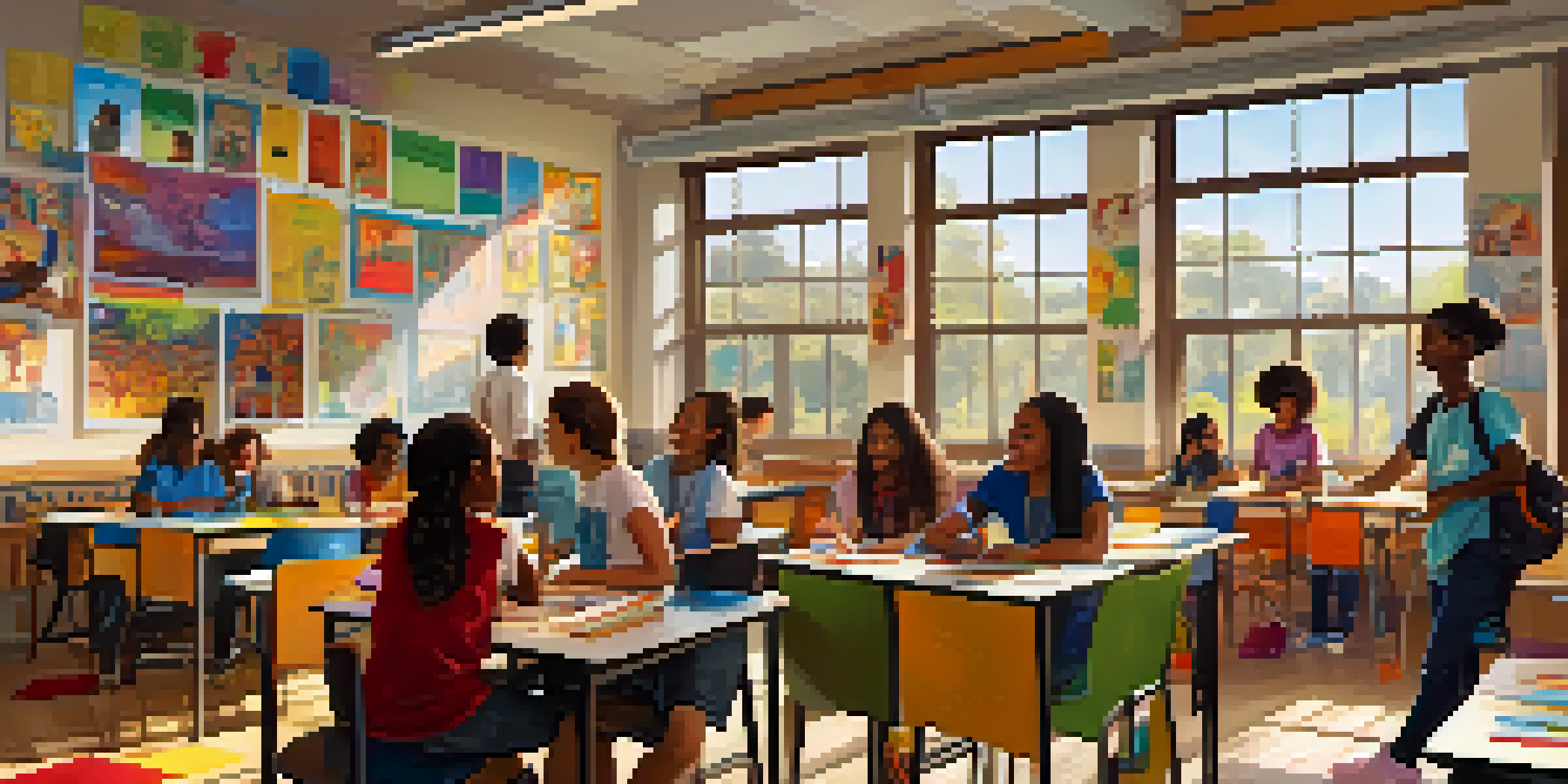Integrating Diverse Cultures into Curriculum Design

Understanding the Importance of Cultural Diversity in Education
Cultural diversity in education enriches the learning environment, making it more inclusive and engaging for all students. When students see their own identities and experiences reflected in the curriculum, they feel valued and understood. This not only boosts their confidence but also enhances their academic performance. By embracing diverse cultures, educators can foster a sense of belonging and community in the classroom.
Diversity is not a reason for division; it is a reason for celebration.
Moreover, integrating diverse cultures prepares students for a global society. In an increasingly interconnected world, understanding different perspectives is crucial for collaboration and communication. Students learn to appreciate cultural differences, which can lead to more empathetic and informed citizens. This cultural competence is essential for navigating both personal and professional relationships in the future.
Finally, a culturally diverse curriculum promotes critical thinking. When students analyze materials from various cultural viewpoints, they develop the ability to think critically about their own biases and assumptions. This analytical approach encourages deeper discussions and a more comprehensive understanding of complex issues, ultimately leading to a more well-rounded education.
Strategies for Incorporating Cultural Diversity in Curriculum
One effective strategy is to include multicultural literature in reading lists. Stories from various cultures allow students to explore different perspectives and narratives, fostering empathy and understanding. Teachers can guide discussions around these texts, prompting students to reflect on their own experiences in relation to the characters and themes presented.

Another approach is to invite guest speakers from diverse backgrounds to share their experiences and insights. This firsthand perspective can be incredibly powerful, helping students connect theoretical concepts to real-world applications. Additionally, organizing cultural events or projects can further immerse students in diverse traditions and practices, making learning more dynamic and interactive.
Cultural Diversity Enhances Learning
Incorporating cultural diversity in education enriches the learning environment and boosts students' confidence and performance.
Finally, educators should consider collaborating with community organizations that focus on cultural diversity. These partnerships can provide resources, expertise, and support for curriculum development. By tapping into local cultural resources, educators can create a more relevant and contextually rich learning experience that resonates with students.
Challenges in Integrating Cultural Diversity
While integrating cultural diversity into the curriculum is essential, it comes with challenges. One major hurdle is the lack of resources or training for educators on how to approach diverse perspectives. Without proper support, teachers may feel overwhelmed or uncertain about how to effectively incorporate these elements into their lessons.
Education is the most powerful weapon which you can use to change the world.
Additionally, there might be resistance from parents or school boards who are hesitant about changes in the curriculum. Some may feel that introducing diverse perspectives could undermine traditional values or historical narratives. It's important to address these concerns through open communication and education about the benefits of a more inclusive curriculum.
Lastly, educators may struggle with finding a balance between covering required standards and integrating diverse content. It can be challenging to ensure that all students are meeting academic benchmarks while also exploring varied cultural perspectives. However, with thoughtful planning and creativity, it's possible to weave diversity into the fabric of the curriculum without sacrificing academic rigor.
Creating an Inclusive Classroom Environment
An inclusive classroom environment is crucial for the successful integration of diverse cultures into the curriculum. Teachers can create this atmosphere by establishing ground rules that promote respect and open-mindedness during discussions. By encouraging students to share their own cultural backgrounds, educators foster a sense of community and belonging.
Incorporating visual aids and materials that reflect diverse cultures can also enhance inclusivity. Displays of art, music, and artifacts from various cultures can spark interest and curiosity among students. When students see their own cultures represented alongside others, it validates their experiences and encourages engagement.
Strategies for Inclusion in Classrooms
Effective strategies like multicultural literature and guest speakers can make the curriculum more engaging and relevant.
Furthermore, using cooperative learning strategies can help students work together while appreciating each other's differences. Group projects that require collaboration among students from diverse backgrounds can promote teamwork and respect. This not only enriches the learning experience but also builds essential social skills for future success.
Assessment Methods for Culturally Diverse Learning
Assessing students in a culturally diverse curriculum requires flexibility and creativity. Traditional testing methods may not fully capture the understanding and engagement of students from different backgrounds. Therefore, educators should consider alternative assessment strategies, such as project-based learning or presentations, which allow students to showcase their knowledge in varied ways.
Incorporating self-assessment and peer reviews can also promote reflection and critical thinking. These methods encourage students to evaluate their own learning and consider the perspectives of their classmates. By fostering this collaborative assessment environment, educators can create a more comprehensive understanding of student learning.
Moreover, feedback should be culturally responsive, acknowledging the diverse backgrounds of students. Educators can frame feedback in a way that respects and uplifts students' identities, encouraging them to continue exploring and expressing their cultural perspectives. This not only enhances learning but also builds confidence and motivation.
The Role of Technology in Culturally Diverse Curriculum
Technology plays a pivotal role in expanding access to diverse cultural resources. Online platforms and digital libraries provide a wealth of literature, art, and multimedia content from various cultures. Educators can leverage these resources to enrich their curriculum and introduce students to global perspectives they might not encounter otherwise.
Virtual exchanges and collaborations with classrooms around the world can also enhance cultural understanding. These initiatives allow students to interact with peers from different backgrounds, fostering global citizenship. By engaging with diverse voices, students can better appreciate the richness of different cultures and traditions.
Technology Expands Cultural Access
Utilizing technology provides access to diverse resources and fosters global citizenship among students.
Additionally, technology can facilitate differentiated instruction tailored to students' varying cultural backgrounds. Educators can create personalized learning experiences that resonate with individual students, making the curriculum more relevant and engaging. This adaptability is essential for meeting the needs of a diverse student population.
Future Directions for Culturally Responsive Curriculum Design
As the landscape of education continues to evolve, the need for culturally responsive curriculum design will only grow. Educators and curriculum developers must stay informed about emerging cultural trends and the needs of diverse student populations. Continuous professional development and collaboration among educators can help address these dynamic challenges.
Furthermore, involving students in curriculum design can lead to more relevant and engaging content. By soliciting feedback and input from students about their cultural experiences and interests, educators can create a curriculum that truly reflects the voices of the learners. This participatory approach not only empowers students but also fosters a sense of ownership over their education.

Ultimately, the goal is to create an educational environment that values and celebrates diversity. By prioritizing culturally responsive curriculum design, we can prepare students for a more inclusive and interconnected world. Embracing diverse cultures in education is not just beneficial—it's essential for cultivating informed, empathetic, and engaged citizens.